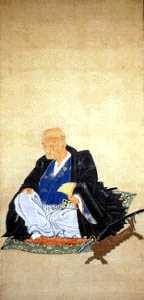Niwa Nagatomi
| Niwa Nagatomi | |
|---|---|
 | |
| Niwa Nagatomi | |
| Lord of Nihonmatsu | |
| In office 1814–1858 | |
| Preceded by | Niwa Nagaaki |
| Succeeded by | Niwa Nagakuni |
| Personal details | |
| Born | October 12, 1803 Edo, Japan |
| Died | August 12, 1866 (aged 62), aged 62 |
| Nationality | Japanese |
Niwa Nagatomi (丹羽長富) (October 12, 1803 – August 12, 1866) was a Japanese daimyo of the late Edo period.
Biography
Nagatomi, known in his childhood as Kakuzō (覚蔵) and later Bankichi (蕃吉), was born in his family's Edo residence in 1803. He was the eldest son of the previous daimyo, Niwa Nagaaki. At age 11, due to the death of his father, he inherited the family headship, becoming 10th generation lord of Nihonmatsu han. Nagatomi relied heavily on his karo, the famed Niwa Takaaki. He encouraged his retainers to excel in the martial and literary arts, and to that end, sponsored the opening of the domain's official school, Keigakukan (敬学館).[1] In 1822, during economic issues prior to that, he deployed domain forces to put down a peasant uprising. He also helped revive the domain's economic situation following a seven year string of famines during the Tenpo era. His domain, together with Aizu han, was in charge of security at the Futtsu artillery emplacement during the Perry Mission. Citing health reasons, Nagatomi stepped down from headship in 1858, and was succeeded by his sixth son Nagakuni in 1858.
Nagatomi's children went on to become famous in the Bakumatsu period. Inaba Masakuni, lord of Yodo and member of the roju council, was one of his sons; Mizuno Katsutomo of Yūki han was another. Nagatomi held the title of Sakyō-dayū (左京太夫), and the junior 4th court rank, lower grade (jū shi-i no ge 従四位下).[1]
Notes
| Preceded by Niwa Nagaaki |
Daimyō of Nihonmatsu 1814-1858 |
Succeeded by Niwa Nagakuni |
Further reading
- Nihonmatsu-han shi 二本松藩史. Tokyo: Nihonmatsu-hanshi kankōkai 二本松藩史刊行会, 1926 (republished by Rekishi Toshosha 歴史図書社, 1973)
- Sugeno Shigeru 菅野与. Ōshū Nihonmatsu-han nenpyō 奥州二本松藩年表. Aizu-Wakamatsu shi 会津若松市: Rekishi Shunjūsha 歴史春秋社, 2004.
External links
- Genealogy of the Niwa clan of Nihonmatsu (in Japanese)
- Biography of Nagatomi (in Japanese)